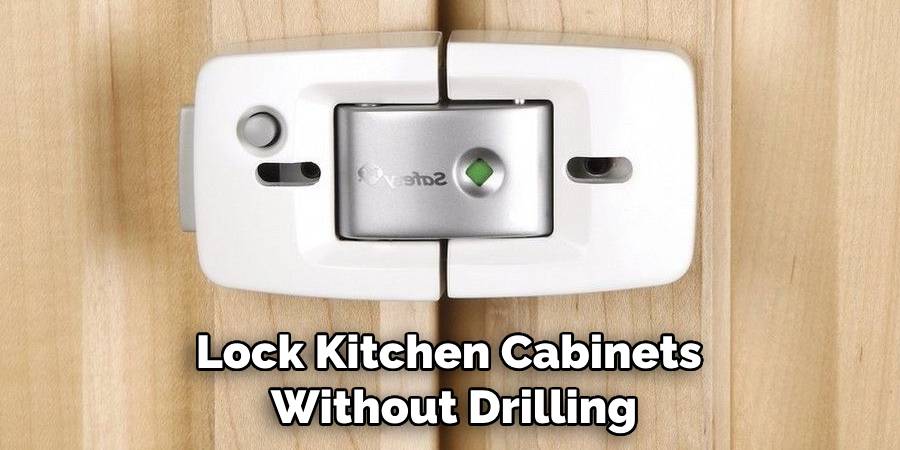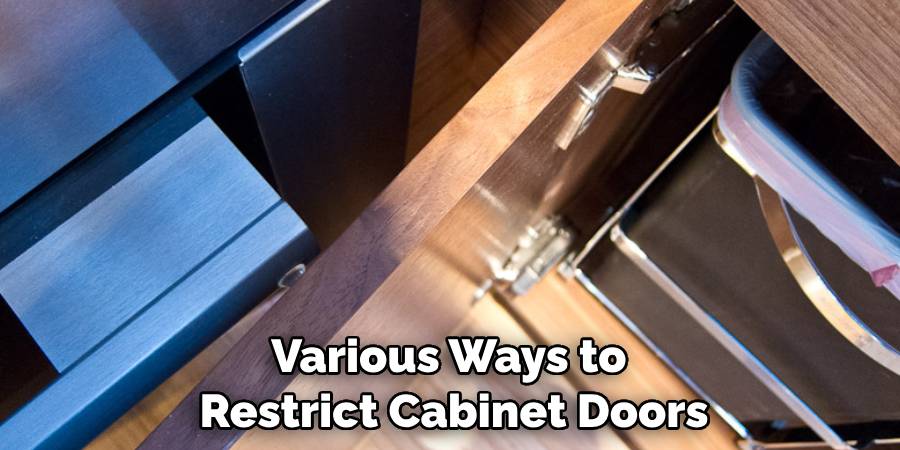Are you tired of your kids sneaking into the kitchen and raiding the pantry? Or maybe you’re just looking for a way to keep your kitchen cabinets secure and organized? Well, you’re in luck because, in this blog post, we’ll be sharing some top tips and tricks on how to lock kitchen cabinets. Whether you have mischievous little ones or you simply want to maintain a pristine and clutter-free kitchen, these strategies will provide you with the peace of mind you’ve been searching for. So grab a cup of coffee and get ready to transform your kitchen into a fortress of organization and safety.

Types of Cabinet Locks
There are several types of cabinet locks available on the market. Each type has its advantages and disadvantages, so it’s important to choose the right one for your needs.
- Magnetic Locks: These use magnetic keys to open and close the lock. They are invisible from the outside and do not require any drilling or screws, making them a great option for those who want a discreet locking solution.
- Padlocks: These are the traditional locks that require a key or combination to open. They are durable and can be used on any type of cabinet, but may not be the most aesthetically pleasing option.
- Latches: Latches are similar to padlocks in function, but they use spring-loaded mechanisms instead of keys. They are easy to install and can be used on cabinets with handles or knobs.
- Combination Locks: These locks require a specific code or sequence of numbers to open. They offer a high level of security but can be difficult to use if you forget the combination.
Top 5 Method on How to Lock Kitchen Cabinets
1 . Use a Padlock
One of the most secure ways to lock kitchen cabinets is to use a padlock. This type of lock requires a key to open and can be easily installed on any cabinet door. Padlocks are available in a variety of sizes and styles, so you can choose one that best fits your needs. Additionally, padlocks can be used to secure multiple cabinets at once or just one individual cabinet.
2 . Install Latches
Another way to lock kitchen cabinets is to install latches on the doors. Latches come in several different varieties, such as spring-loaded latches, magnetic latches, and push-button latches. Most latches require no additional hardware and are easy to install with just a screwdriver. Latches provide an added layer of security and can be used in combination with other locks for extra protection.

3 . Utilize Cabinet Locks
Cabinet locks are another option for locking kitchen cabinets and come in both keyed and non-keyed versions. Keyed cabinet locks require a key to open while non-keyed locks have a combination that must be entered to unlock them. Cabinet locks are generally more secure than other types of locks because they cannot be picked or bypassed with brute force alone.
4 . Use Combination Locks
Combination locks are another type of lock that can be used to secure kitchen cabinets. These types of locks do not require a key and instead rely on a combination code that must be entered for the lock to open. Combination locks offer an added layer of security as they cannot be picked or bypassed like other types of locks can.
5 . Install Sliding Bolts
Sliding bolts are another option for locking kitchen cabinets and provide an extra level of security when compared to other types of locks. These types of bolts typically require screws or nails for installation but once installed they provide an effective barrier against unwanted access to the cabinet space below them. Sliding bolts come in both keyed and non-keyed varieties so you can choose the one that best suits your needs.
How to Install Magnetic Cabinet Locks
The installation process for cabinet locks varies depending on the type you choose. However, here are some general steps to follow:

- Determine the type of cabinet lock you want to use and purchase it.
- Clean the surface where the lock will be installed to ensure proper adhesion.
- Follow the manufacturer’s instructions for installation. This may involve drilling holes, attaching screws, or using adhesive strips.
- Test the lock several times to make sure it is secure and functioning properly.
Maintenance Tips
To ensure your cabinet locks continue to work effectively, here are some maintenance tips to keep in mind:
- Regularly clean the lock with a mild detergent and water to remove any dirt or debris that may prevent it from working properly.
- Check the lock periodically for any signs of wear or damage, and replace it if necessary.
- If using a magnetic lock, make sure the magnets are still strong and securely attached to both the cabinet and the key.
- Teach children not to play with or try to open locked cabinets, as this can damage the lock or potentially harm them.
- If using a combination lock, make sure to remember or write down the code in a safe place.
Frequently Asked Questions
How Do You Lock Cabinets Without Drilling?
Kitchen cabinets are an essential part of any home and are used to store valuable items such as kitchen appliances, dinner sets, and utensils. However, it can be challenging to keep these items safe when you have children or pets who like to explore. Fortunately, there are ways to lock kitchen cabinets without drilling, and they are just as effective as those that require drilling. One option is to use adhesive magnetic locks, which can be easily installed on the inside of your cabinet doors and remain hidden from view.
These locks are perfect for pet owners or parents with small children who need to keep their kitchen cabinets safe. Another option is to use cable ties or zip ties to secure the cabinet doors. Simply wrap the cable tie around the handles or knobs and secure it tightly. By using these simple and affordable solutions, you can enjoy peace of mind knowing that your kitchen cabinets are safely locked without drilling.

How Can I Keep My Kitchen Cabinets Closed?
Keeping kitchen cabinets closed can be a challenge, especially when you have curious or mischievous kids or pets roaming around. The last thing you want is to find your expensive china or fragile glassware shattered on the floor. Fortunately, there are several ways to lock your kitchen cabinets and keep your precious belongings safe. You can use magnetic locks, adhesive locks, or even a simple rubber band to keep the doors tightly closed.
By taking these simple steps, you can not only prevent accidents but also keep your kitchen organized and clutter-free. So go ahead, protect your valuable kitchenware, and enjoy a hassle-free cooking experience!
How Do You Restrict Kitchen Cabinet Doors?
Is your kitchen cabinet often prone to invasion by nosy children or curious pets? Worry no more; locking your kitchen cabinets is an adequate solution to the problem. Despite their usefulness, kitchen cabinets can pose a significant risk for accidents or may store dangerous items. It is recommended to understand how to lock kitchen cabinets adequately.
Notably, there are various ways to restrict cabinet doors, such as magnetized locks, sliding locks, child safety latches, or adhesive lock systems. Each method has unique features, pros, and cons that fit the various needs and preferences of different individuals. By selecting a locking solution that suits your situation best, you can be sure of enjoying peace of mind at home while maintaining a secure environment for everyone.

Conclusion
In conclusion, protecting your kitchen from curious young children and intruders is an important job, and there are many ways to lock kitchen cabinets – from simple padlocks to magnetic child locks. All of these solutions will provide you with the peace of mind needed to ensure your family’s safety while still having fun in your kitchen. Ultimately, it all comes down to what best fits your needs.
With this information in hand, you should now have a better understanding of how to lock kitchen cabinets and secure them with confidence. So don’t wait any longer; get out there and start exploring the right security solution for your family today! Make sure to ponder the benefits and features of the choices available so you can make an educated decision on which one is right for you.
